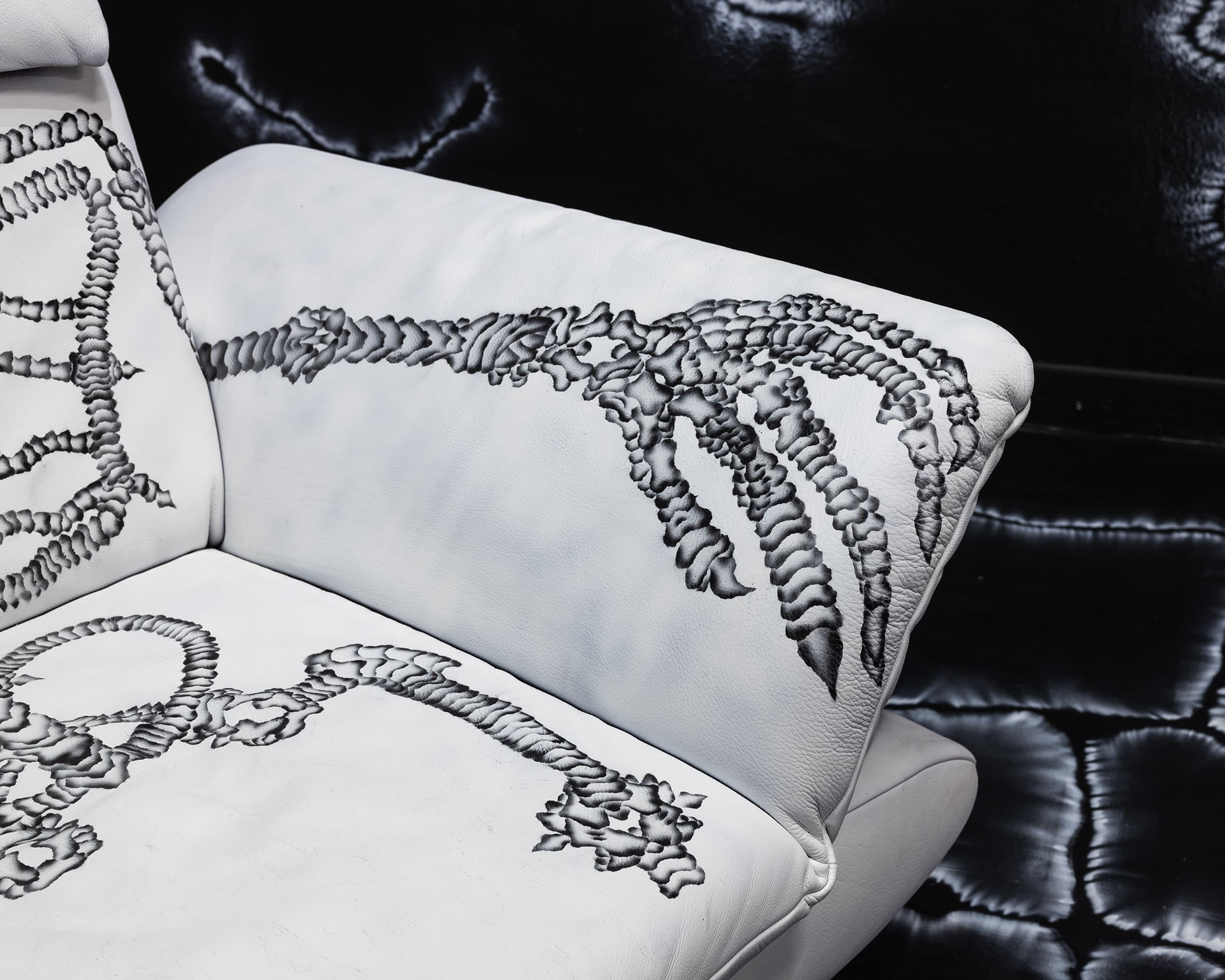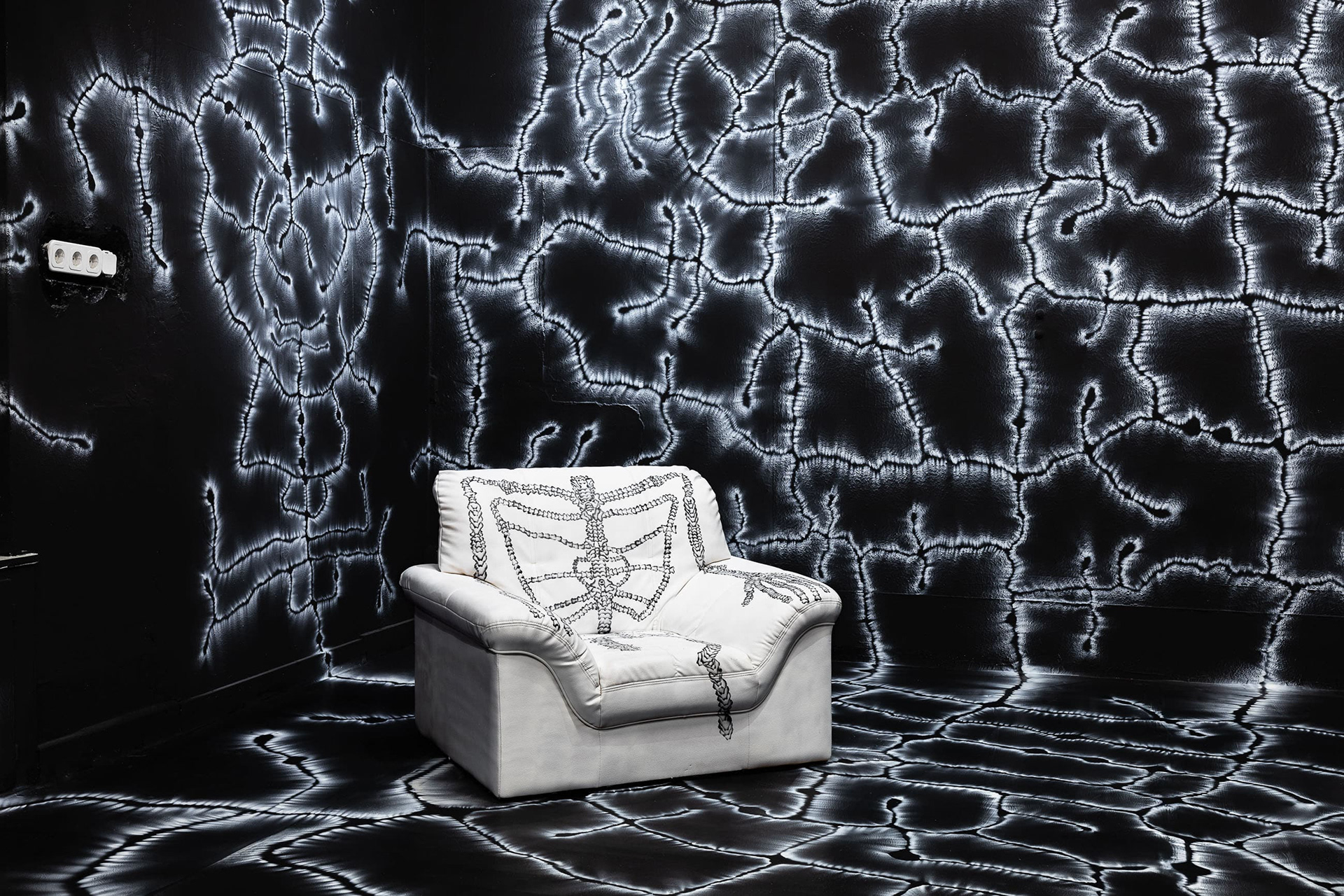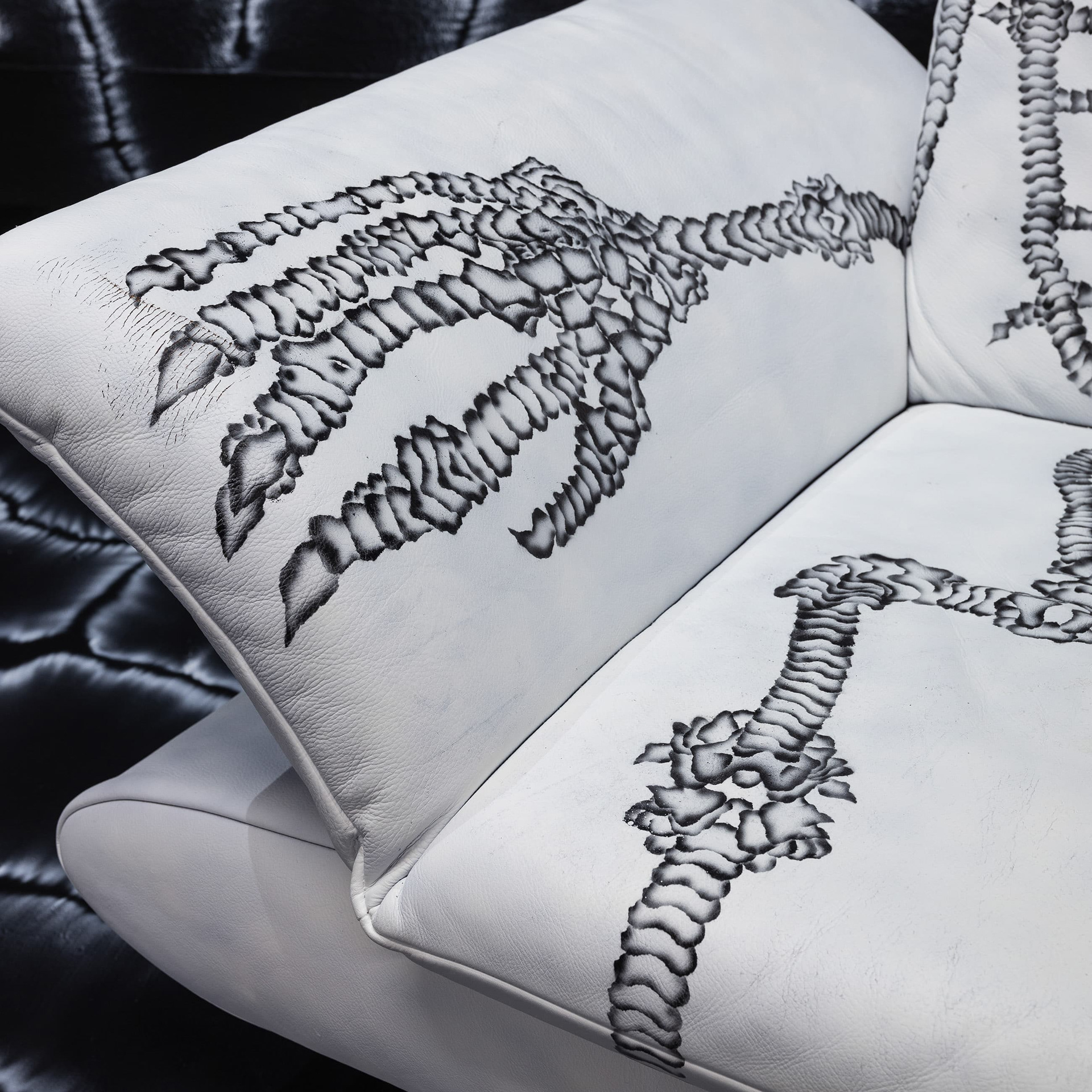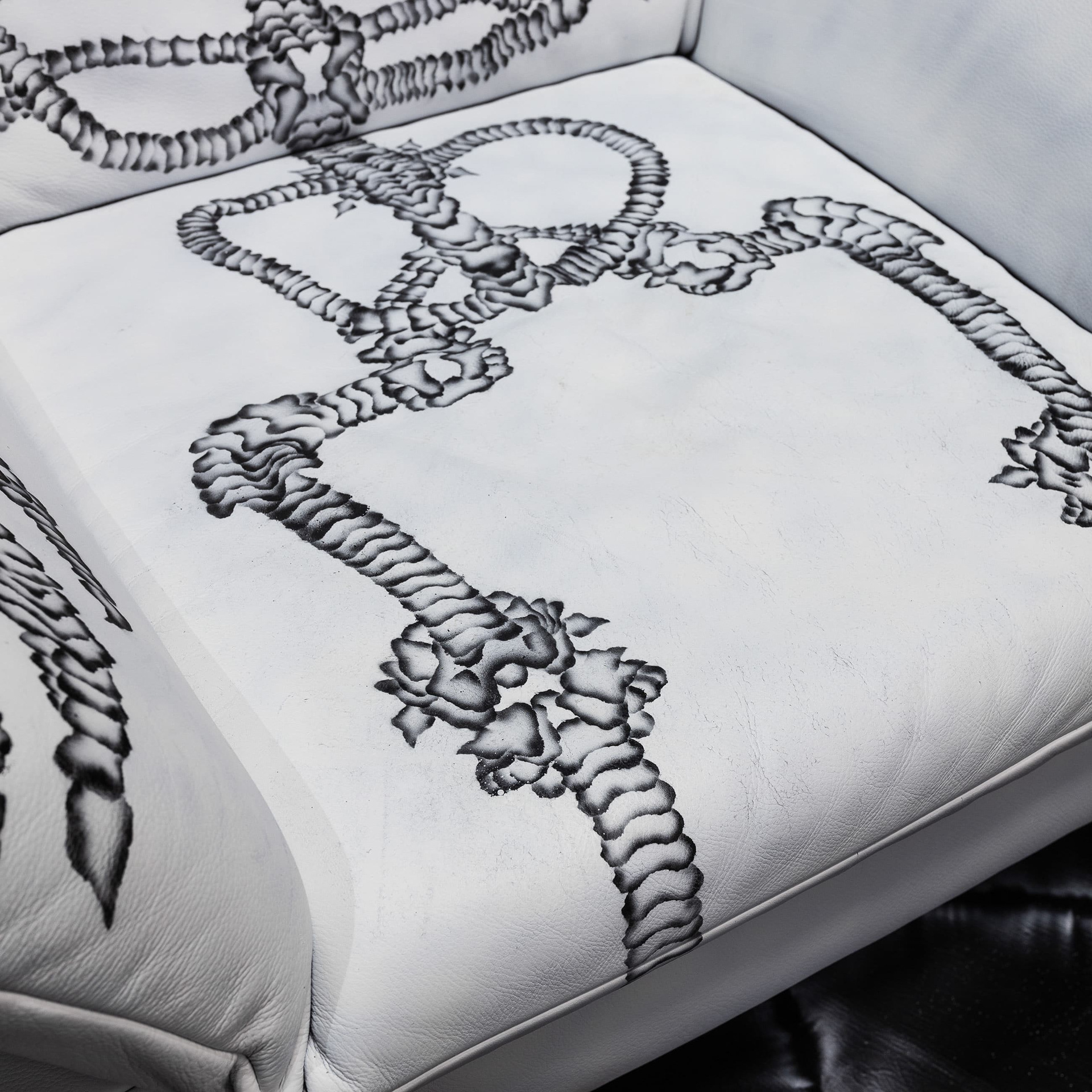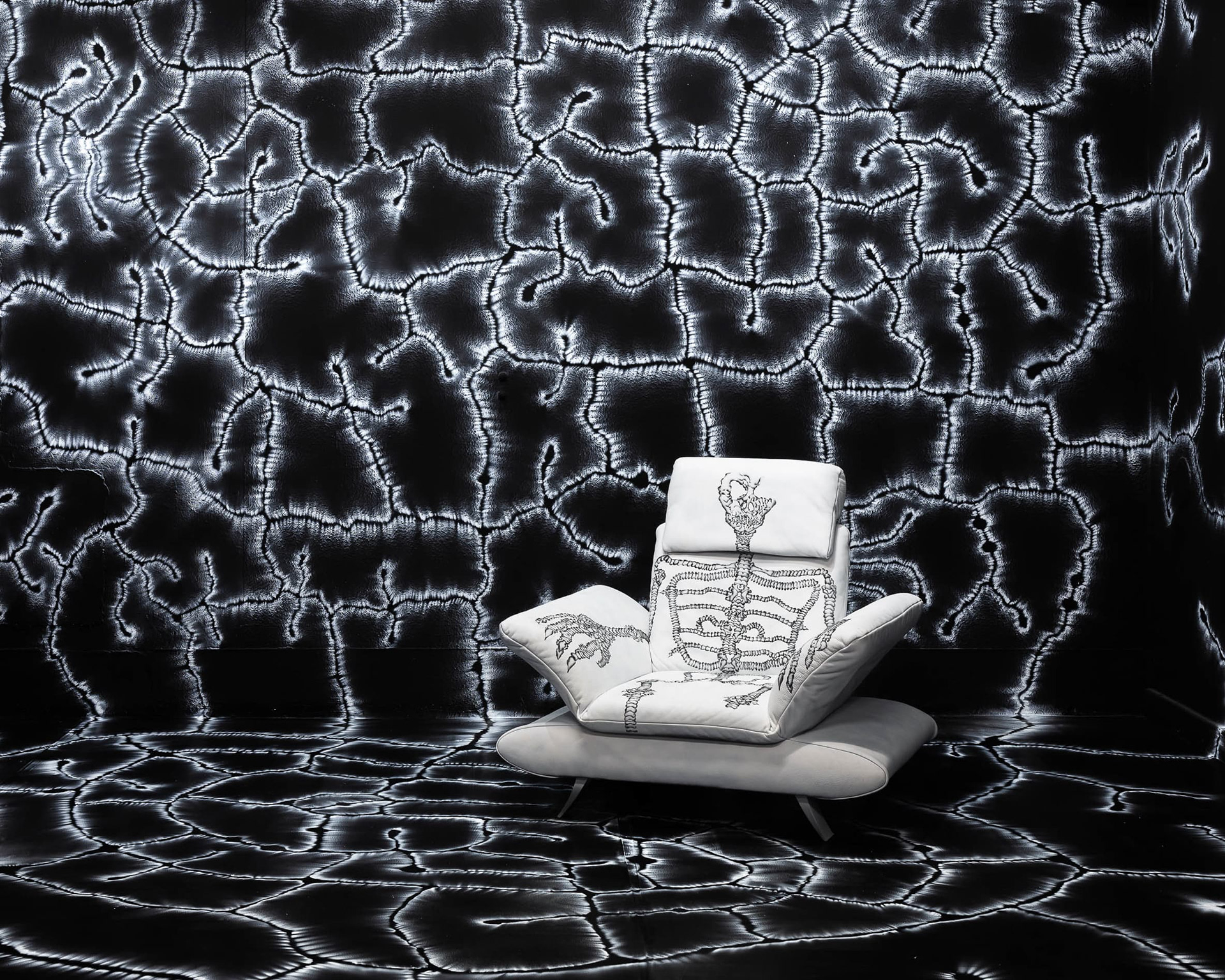Chamber Of Decay
The painter, sculptor and installation artist Stach Szumski (*1992) lives and works at the foot of the Giant Mountains (Karkonosze) near the Polish-Czech border, an area he has roamed since childhood. There, forms of post-Soviet industrial skeletons and ore mines meet forest and mountain structures, whose reciprocal traces became the early form school of his work. Rough interventions in the landscape, decay and reconquest by nature here contrast the hundreds of millions of years old massif with its granite ridge and extraordinary formations such as terraces, rock towers and deeply furrowed plateaus.
Sensitised by this, Szumski carries out explorations through divergent form landscapes, observes aesthetic potentials of visual extracts and examines the coherence of found structures with those of other sign systems. Strolling, hiking and interventions on site then lead to the transcendence of path and distance, imagination and action, which is decisive for Szumski's artistic process. He uses various sculptural materials, spray paint or airbrush as instruments for transferring his own stream of consciousness into the material.
The path of the movements of his formations draws synaptic strands, neuronal networks or sign-like architectures that work their way into the painting ground, breathe on it and drive the surface into outgrowths and into ravines. An archetype emerges that works from the inside out. As an extension of the memory steps of the wandering, the artist creates "Gedankendinge" in the sense of Kant: Paintings and objects whose intuitive process of creation thus represent cognition and generate phenomena that in their sign-like quality constitute a communicative act that Szumksi carries out together with wall and space.
The artist's research into signs, writing and gestural prints via graffiti writing and its echoes in structures of rocks and caves, of forest fauna and industrial skeletons of Lower Silesian childhood places, releases new communicative structures in situative relation to the painting surface. Here he touches the wall or canvas with a typical handle, allowing structures and drawing landscapes to swell and expand, lines become bodies, connections of their form elevations and valleys. Szumksi uses various artistic methods to express a way of dealing with structures of traces and what is left behind; semiotically or architecturally, the artist pursues an analysis of form, which he juxtaposes with natural "Gestalt" expressions. In this way, complex overlaps and morphings emerge from stored visual impressions of man-made signs, two- or three-dimensional artefacts that are processed with abstract forms of geological growth such as stalactites or corals.
Sensitised by this, Szumski carries out explorations through divergent form landscapes, observes aesthetic potentials of visual extracts and examines the coherence of found structures with those of other sign systems. Strolling, hiking and interventions on site then lead to the transcendence of path and distance, imagination and action, which is decisive for Szumski's artistic process. He uses various sculptural materials, spray paint or airbrush as instruments for transferring his own stream of consciousness into the material.
The path of the movements of his formations draws synaptic strands, neuronal networks or sign-like architectures that work their way into the painting ground, breathe on it and drive the surface into outgrowths and into ravines. An archetype emerges that works from the inside out. As an extension of the memory steps of the wandering, the artist creates "Gedankendinge" in the sense of Kant: Paintings and objects whose intuitive process of creation thus represent cognition and generate phenomena that in their sign-like quality constitute a communicative act that Szumksi carries out together with wall and space.
The artist's research into signs, writing and gestural prints via graffiti writing and its echoes in structures of rocks and caves, of forest fauna and industrial skeletons of Lower Silesian childhood places, releases new communicative structures in situative relation to the painting surface. Here he touches the wall or canvas with a typical handle, allowing structures and drawing landscapes to swell and expand, lines become bodies, connections of their form elevations and valleys. Szumksi uses various artistic methods to express a way of dealing with structures of traces and what is left behind; semiotically or architecturally, the artist pursues an analysis of form, which he juxtaposes with natural "Gestalt" expressions. In this way, complex overlaps and morphings emerge from stored visual impressions of man-made signs, two- or three-dimensional artefacts that are processed with abstract forms of geological growth such as stalactites or corals.
Compositional mixtures or assemblages emerge, that, between alien-mystical, sacrally charged and code-connotated connections of form, also show organic and landscape entanglements: Creatural signs that often seem moving in themselves and take on different roles. Here, the path to finding form, the path to the venue, is part of the trance rite Szumski continues to shape in the artistic action and serves as a binding agent for the constructs. The action towards painting or sculpture also includes a performance; the discharge of energy often only leads to a visual echo through climbing and drifting. Painting instruments and surroundings themselves often require a dance-like dedication:
In the same way that wandering through a landscape nestles dancelike against the ground, arms and legs thereby turning the outline of the body into signs, Szumski's flow is a reproduction of the processes of his fieldwork in caves, in the mountains, under reefs.
Just as the wanderer acquires the appropriation of the subsoil, picks up material, the boot treads it out and its track becomes a drawing path, a ductus - so the artist travels along concrete and canvas with tools that become vehicles of his thoughts.
For this, the path is stored in movements, geological formations being absorbed, climbed, while stumble and injuries are breaks in perception and lead to the deflection of the line. Just as the surrounding space conditions the painting process, Szumki's interest in semiotics and iconology is equally the developer of a trance. When the light between branches and cracks decorates the melody, shadows cast tribals and mouches volantes ornament the world, new connections of a logic of their own emerge, fusing space and painting surface, sculpture and setting, into a shaping stimulus. The performative element complements this flow to an intuitive action and is at the same time an aesthetic method.
In the same way that wandering through a landscape nestles dancelike against the ground, arms and legs thereby turning the outline of the body into signs, Szumski's flow is a reproduction of the processes of his fieldwork in caves, in the mountains, under reefs.
Just as the wanderer acquires the appropriation of the subsoil, picks up material, the boot treads it out and its track becomes a drawing path, a ductus - so the artist travels along concrete and canvas with tools that become vehicles of his thoughts.
For this, the path is stored in movements, geological formations being absorbed, climbed, while stumble and injuries are breaks in perception and lead to the deflection of the line. Just as the surrounding space conditions the painting process, Szumki's interest in semiotics and iconology is equally the developer of a trance. When the light between branches and cracks decorates the melody, shadows cast tribals and mouches volantes ornament the world, new connections of a logic of their own emerge, fusing space and painting surface, sculpture and setting, into a shaping stimulus. The performative element complements this flow to an intuitive action and is at the same time an aesthetic method.
The exhibition taking place in the Saarbrücken project space Automat moves us into the cave. The space becomes a chamber of the architecture's subconsciousness. Szumski preserves his appropriation in interwoven signs that peel a skeleton out of the spatial structure: A scaffolding in dissolution that conceals countless independent readings in its remaining line rhythms. Ramifications dock onto spatial grids and write a three-dimensional crypto-font that demands from the bony audience a rite of reception that is once again dance-like.
Stach Szumski's first solo exhibition in Germany presents an immersive environment between walk-in painting and installative setup, created exclusively for the show.
Stach Szumski's first solo exhibition in Germany presents an immersive environment between walk-in painting and installative setup, created exclusively for the show.
Artist: Stach Szumski @stachuszumski
Curator: Timo Poeppel @automat_space
Automat Space | Saarbrücken, Germany


